Bulletin – June 2013 Australian Economy Australian Exports: Global Demand and the High Exchange Rate
- Download the article 380KB
Abstract
Growth in Australian exports was weaker than had been expected over the past 10 years across all major categories: resources, rural, manufactures and services. While exports of bulk commodities and liquefied natural gas (LNG) grew strongly in response to higher demand from Asia, this was partly offset by declines in exports of oil and processed metals. Non-resource exports have been adversely affected by the appreciation of the exchange rate and the ongoing rise in the share of global production occurring in emerging economies. Looking ahead, the surge in mining-related investment since the mid 2000s is expected to lead to stronger growth in resource exports over the next five years. As incomes grow further in emerging Asia, demand for Australia's exports of food products, high-skilled manufactures and services is also expected to rise.
Introduction
Australian exports are heavily influenced by trends in global demand and Australia's competitiveness in international markets. As a major exporter of resource commodities, the resource-intensive nature of the rapid growth in emerging Asia has been an important driver of developments over the past 10 years. Over the same period, the competitiveness of Australia's non-resource exporters has been reduced by the appreciation of the exchange rate, which has lowered export revenue relative to domestic production costs.
Export growth over the past 10 years was consistently below the expectations of the Bank and other macroeconomic forecasters – even though the rapid growth in Asia, and in particular China, exceeded consensus forecasts over the period (Connolly and Orsmond 2011). The slowdown in exports was broadly based across resource, rural, manufactured and services exports (Graph 1, Table 1).
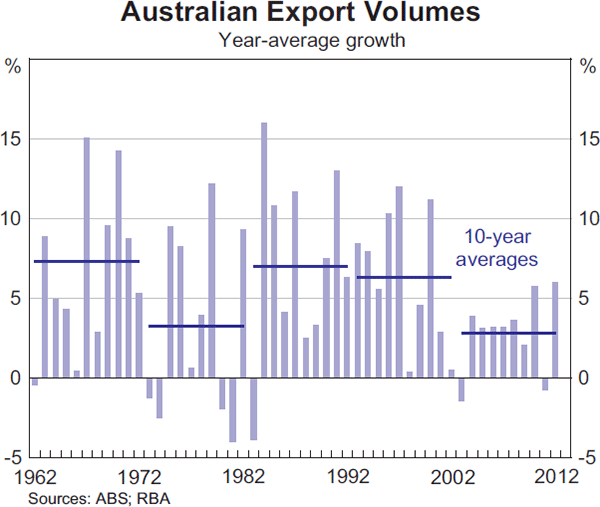
| 1973–1982(a) | 1983–1992 | 1993–2002 | 2003–2012 | |
|---|---|---|---|---|
| Resources | 2.9 | 8.5 | 4.7 | 3.6 |
| Rural | 2.3 | 2.6 | 4.4 | 2.1 |
| Manufactures | 6.8 | 11.2 | 10.4 | 2.4 |
| Services | 4.8 | 7.8 | 7.1 | 1.2 |
| Total | 3.3 | 7.0 | 6.3 | 2.8 |
|
(a) Resources, rural and manufactured growth rates are calculated for 1976–1982 Sources: ABS; RBA |
||||
While most advanced economies experienced slower growth in exports, the reasons for the slowdown in Australia were somewhat different than for other advanced economies (Graph 2). This reflects the fact that Australia is predominantly a commodity exporter, while other advanced economies typically export a higher share of manufactures and services. Manufacturers have been facing increasing competition from lower-cost producers in developing Asia. In addition, other advanced economies were more heavily affected than Australia by the downturns in the global business cycle in the early 2000s and during the global financial crisis. In contrast, Australia's exports slowdown was driven more by supply constraints on resource exports and the appreciation of the exchange rate weighing on non-commodity exports.
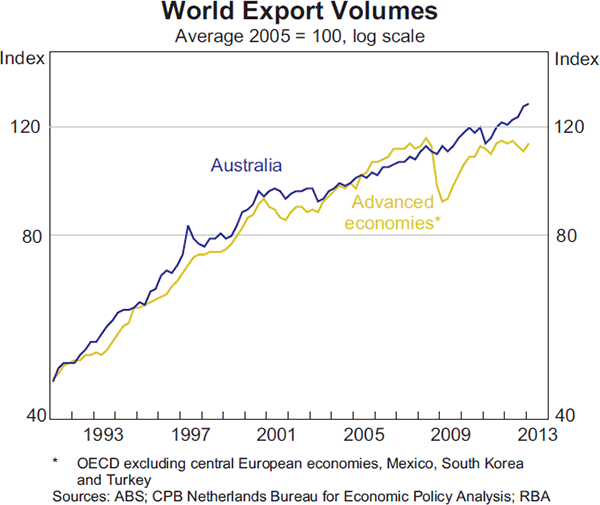
There are some interesting parallels between the recent slowdown in Australian exports and the previous slowdown from the mid 1970s to the early 1980s: the world economy experienced two downturns relatively close together in the mid 1970s and the early 1980s; in addition, commodity prices rose strongly through the 1970s, investment in resources surged and Australia's real exchange rate was at a relatively high level earlier in the period. Looking ahead, after the recent surge in resource investment is fully reflected in increased production and export capacity, the prospects for a return to stronger growth of exports over coming years are good.
Demand from Emerging Asia
In response to the rapid growth in emerging Asia, Australia's trade has continued to shift towards Asia and away from more traditional destinations such as the United States and Europe (Graph 3). In 2009, China overtook Japan to become Australia's largest export destination and in 2012 accounted for around a quarter of Australia's exports. Although the growth in exports to China has been driven by resource exports, China has also become an increasingly important source of demand for Australia's rural, manufactured and services exports.

China's increased demand for Australia's resource exports has been a consequence of its rapid industrialisation and urbanisation. Over the past decade, China accounted for most of the growth in world steel production, which required inputs of iron ore and coking coal. China now produces almost half of the world's steel (largely for use in construction and manufacturing) and it has also experienced strong growth in energy consumption, raising demand for Australia's reserves of thermal coal and gas. While China is the largest producer of coal in the world and one of the largest producers of iron ore, the scale of its growing demand for these commodities has inevitably made it increasingly reliant on global markets, resulting in a rising share of Australian resource exports going to China (Graph 4). At the same time, there has been continued growth in resource exports to other economies in Asia. With commodity suppliers initially unable to keep pace with the surge in Chinese demand, global commodity prices rose significantly through the 2000s (Plumb, Kent and Bishop 2013).
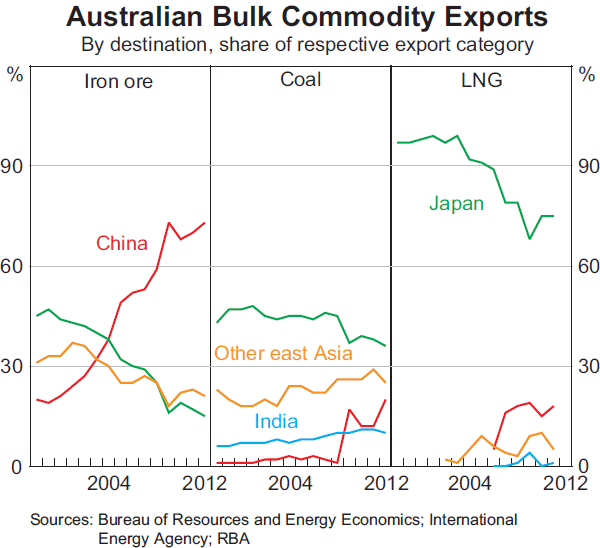
Demand for resources from emerging Asia is expected to continue to grow strongly over the period ahead. So far, China's per capita consumption of steel and energy has followed similar paths to economies such as the United States, Japan and South Korea when they were at equivalent stages of economic development (Graphs 5 and 6). While China's level of steel consumption per capita has already increased substantially, its infrastructure needs remain substantial and steel consumption is likely to continue to grow, albeit at a slower rate than over the past decade.[1] Further, India has a relatively low urbanisation rate and a small manufacturing sector, and its demand for steel and energy could therefore increase considerably (Hyvonen and Langcake 2012).
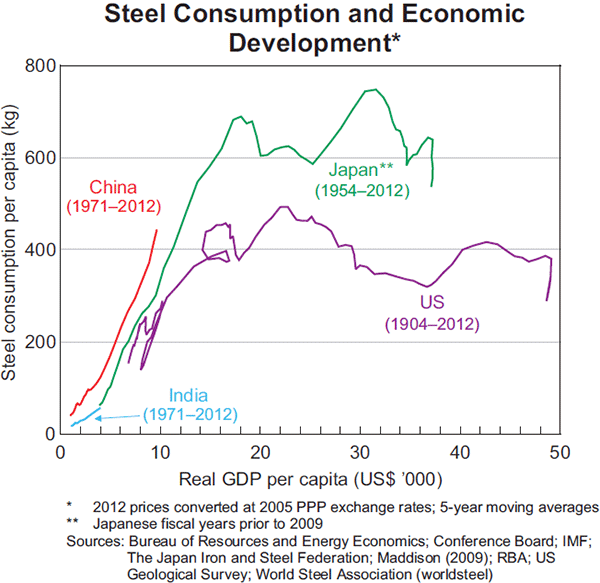
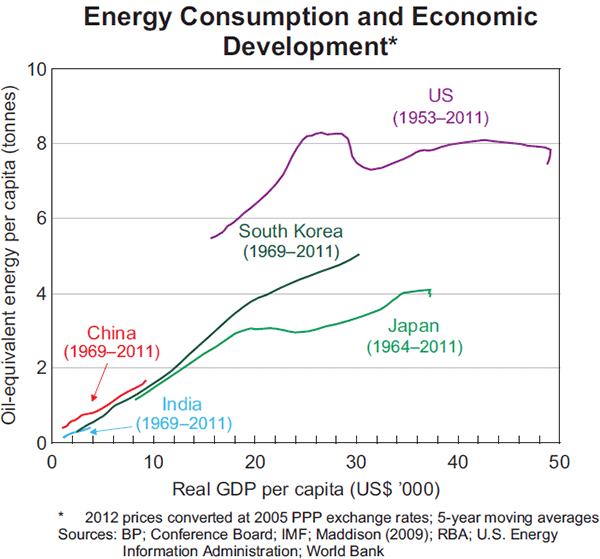
Higher incomes in emerging Asia have also generated increasing demand for Australia's non-resource exports. This has been particularly evident for rural and services exports, although the share of manufactured exports going to emerging Asia has also increased (Graph 7). While Japan remains an important market for Australia's exports, its share of non-resource exports from Australia has fallen as the relative size of Japan's economy in the region has declined and exporters turned to higher-growth markets in emerging Asia.
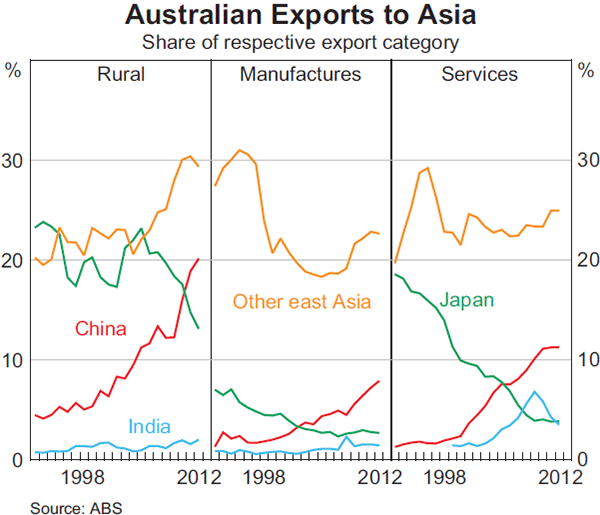
Recognising the importance of fostering trade linkages with Asia, Australia has entered into a number of free trade agreements with economies in the region since 2000, including Malaysia, Singapore and Thailand. Along with New Zealand, Australia has also entered into a regional free trade agreement with the Association of South East Asian Nations (ASEAN), and negotiations aimed at achieving further trade liberalisation with other economies in the region continue, including with China, India, Japan and South Korea (Australian Government 2012).
Relative Prices and Competitiveness
Movements in commodity prices and the exchange rate have driven divergent trends in the competitiveness of the nation's resource and non-resource exporters over the past 10 years.
In response to the surge in Chinese demand for resources, resource export prices increased considerably, boosting the profitability of Australia's commodity exporters. However, the accompanying appreciation of the exchange rate has placed downward pressure on non-resource export prices relative to the domestic costs they face (Graph 8). This has been most evident for manufactured export prices, with declines in world prices, especially for high-tech electronic goods, also contributing.
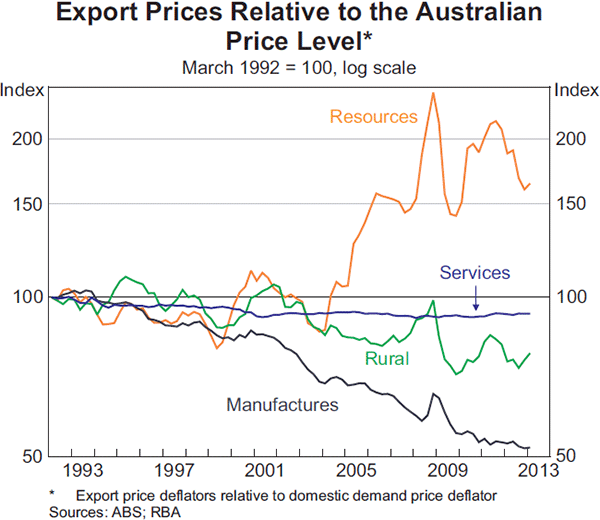
These trends in relative prices have affected growth in export volumes and their contribution to Australian economic growth. After a period of relatively subdued commodity prices and low investment, Australia's resource industries were not able to increase supply rapidly in response to the surge in demand from China, and resource exports grew at a slower pace than the broader Australian economy through the early to mid 2000s (Graph 9). Subsequently, the strong increase in investment in the resources sector started to flow through to faster volumes growth. In contrast, after growing at a faster pace than the broader economy through the 1990s, manufactured and services exports growth slowed through the mid 2000s, and they have been in relative decline over recent years.
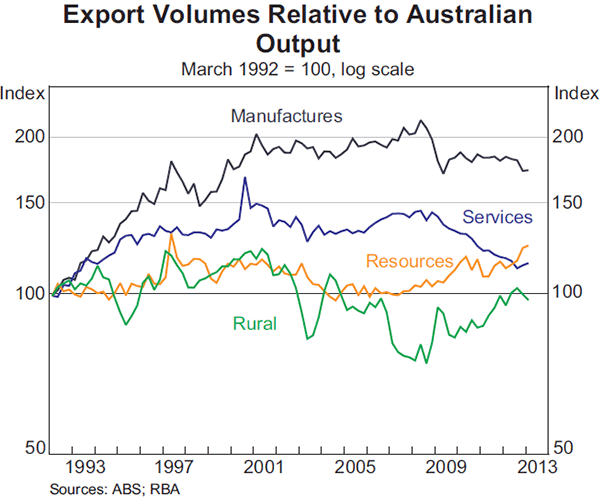
Given these trends in export prices and volumes, the composition of Australia's exports in value terms has shifted substantially towards resource exports (Graph 10). In contrast, the shares of manufactures, rural goods and services in Australian exports have declined to relatively low levels. The remainder of the article provides further detail on the factors that have affected the export performance of Australia's resource, rural and non-commodity exports.
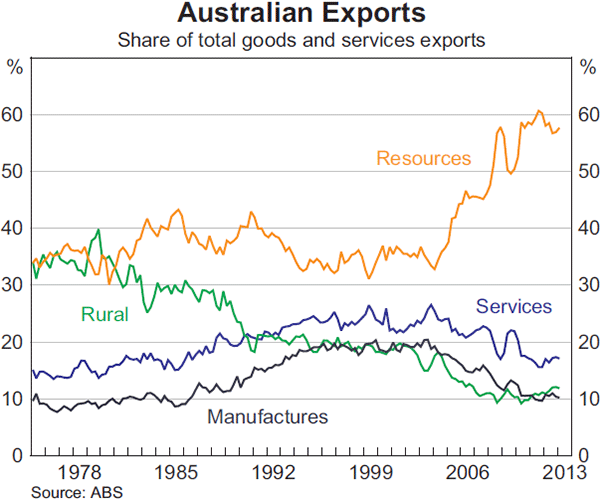
Resource Exports
Supply constraints and future prospects
The composition of Australia's resource exports has shifted over the past 10 years towards iron ore, coal and LNG, and away from oil and processed metals. This shift has been primarily driven by trends in export volumes, with most resource prices increasing substantially over the period, although they have eased back over the past year or so (Table 2). After growing slowly in the early 2000s, iron ore, coal and LNG exports have picked up over recent years following large-scale investment in response to high prices and strong demand from Asia. In contrast, crude oil exports have fallen, reflecting declining production as mature fields are exhausted, while metals manufacturing has faced increasing pressure from the high level of the exchange rate and competition from lower-cost producers in Asia (Connolly and Orsmond 2011).
| Volumes Average annual growth | Prices Average annual growth | Share of total export value |
||||
|---|---|---|---|---|---|---|
| 1993–2002 | 2003–2012 | 1993–2002 | 2003–2012 | 2002 | 2012 | |
| Iron ore | 5 | 12 | 1 | 13 | 3 | 18 |
| Other ores | 4 | 1 | 2 | 8 | 6 | 7 |
| Coal | 5 | 5 | 1 | 7 | 8 | 14 |
| Crude oil | 9 | −1 | 4 | 9 | 4 | 5 |
| LNG | 4 | 11 | 5 | 7 | 2 | 4 |
| Processed metals | 4 | −1 | 1 | 6 | 11 | 9 |
| Total resources | 5 | 4 | 2 | 8 | 35 | 57 |
|
Sources: ABS; Bureau of Resources and Energy Economics; RBA |
||||||
The response of Australia's supply of bulk commodities has been more protracted than expected, partly because of the long lead times between mining investment and production. Labour and equipment shortages, bottlenecks along production chains and the effects of floods have also been significant constraints. While many of these challenges were experienced across industries, it is notable that iron ore exports were able to grow considerably faster than coal exports over the period, albeit not quite at the pace that some producers expected at the outset. Consistent with this, Australia's share of the globally traded iron ore market has risen substantially since 2007, while the share of the coking coal market declined and the share of the thermal coal market has been flat (Graph 11). Australia's iron ore producers not only had the benefit of vertically integrated supply chains, which enabled them to coordinate expansions in infrastructure more easily, but they also operated at the lower end of the global industry cost curve. In contrast, it was more difficult for the coal industry to expand given the fragmented ownership of the mine, rail and port infrastructure and higher costs compared with some other global competitors. Subsequent attempts to coordinate supply chain expansions in New South Wales have resulted in increased export capacity and contributed to faster exports growth from that state over recent years.[2] Severe short-term events have also affected exports; in particular, coal exports from Queensland were hampered by flooding in 2011, with coal shipments only recently surpassing the high level reached in 2010.
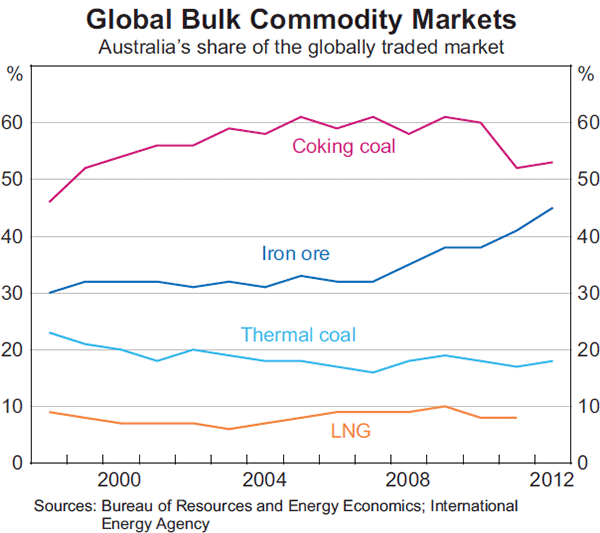
Bulk commodity export volumes are expected to continue growing strongly as the capacity expansions currently under construction are completed. In the latest medium-term outlook of the Bureau of Resources and Energy Economics (BREE), iron ore and coal exports are projected to increase by more than half their current level by 2017/18, and Australia's share of the globally traded market is projected to rise for both of these goods (Graph 12). Given the expectation of a substantial increase in the global supply of bulk commodities, the traded prices of these commodities are expected to continue to decline over coming years.
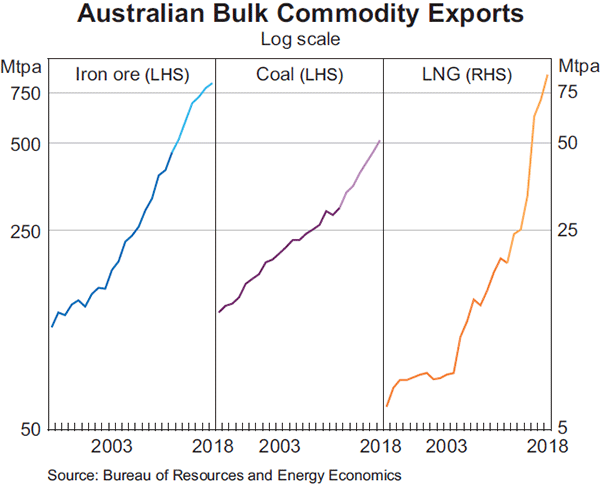
Australian LNG exports have been growing strongly and are expected to more than triple once the projects currently under construction start to be completed from around 2015/16, supported by long-term contracts to supply LNG to major Asian trading partners such as China and Japan. While Australian LNG exports increased rapidly over the past 10 years from a low base, this just maintained Australia's share of the global market in LNG, since supply from competitors such as Qatar also increased at a fast pace (Graph 11). Looking ahead, Australia's global market share would be expected to rise given the sheer magnitude of the LNG projects under construction, although global supply is likely to be given another boost by the exploitation of unconventional gas reserves in the United States and other economies.[3]
Rural Exports
Drought and recovery
Rural exports were subdued over much of the 2000s as a result of prolonged drought, although exports have rebounded over recent years in response to better growing conditions. The recovery has been particularly rapid for cereal grains, textile fibres and oilseeds, which are more sensitive to drought (Graph 13; Rayner, Tan and Ward 2010). The recovery has been more tentative for exports such as meat, wool and dairy products, reflecting the time it takes for herd sizes to recover and the competitive pressures faced by Australian producers, particularly given the appreciation of the exchange rate. Overall, the difficult conditions faced by producers have resulted in global market shares for some of Australia's key rural exports, such as beef and wheat, declining over the past 10 years, although they have recovered recently.
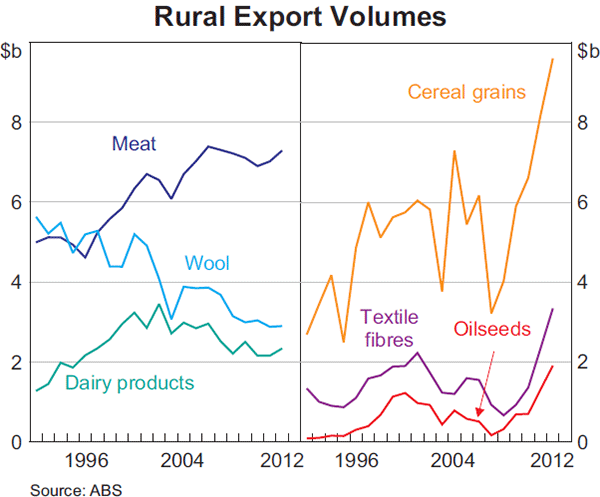
Looking ahead, demand for rural commodities is expected to be supported by ongoing global population growth and rising incomes in emerging Asian economies, with food consumption patterns shifting towards higher-value rural exports. In particular, increasing incomes tend to lead to stronger demand for protein, which can be sourced from meat and dairy products (Rayner, Laing and Hall 2011). These developments are likely to provide opportunities for rural exporters and support prices of food over the medium term.
Manufactured Exports
Responses to the high exchange rate
Australia's manufactured exports have been weakened by the appreciation of the Australian dollar and movements in the global business cycle over recent years, with the effects highlighted by business surveys.[4] In the ACCI/Westpac survey, the sharpest declines in the outlook for exports have occurred during downturns in trading partner growth, such as during the Asian financial crisis and the global financial crisis (Graph 14). Looking through these fluctuations in the business cycle, there has also been a broad relationship between the export outlook and the real exchange rate (which adjusts for differences in domestic inflation across economies). When the real exchange rate was at low levels in the mid 1990s and the early 2000s, the export outlook was relatively positive. In contrast, when the real exchange rate was high in the mid 1970s and again in recent years, manufacturers have been pessimistic about the export outlook. Consistent with this survey evidence, the combination of the global financial crisis and the further appreciation of the Australian dollar led to a sharp fall in Australia's manufactured exports in 2008/09 and the recovery over the past four years has been relatively subdued, with exports remaining well below their 2008 peak.

In addition to these factors, the manufacturing sector has faced increased competition from lower-cost manufacturers in developing Asian economies, particularly China, as reflected in the rising share of those economies in global manufactured exports (Graph 15). In comparison, Australia's share has declined, albeit at a similar pace to other advanced economies. The competitive pressures from emerging Asia have particularly affected Australia's labour-intensive and low-skilled manufactured exports, such as construction materials and textiles, clothing and footwear (Graph 16).
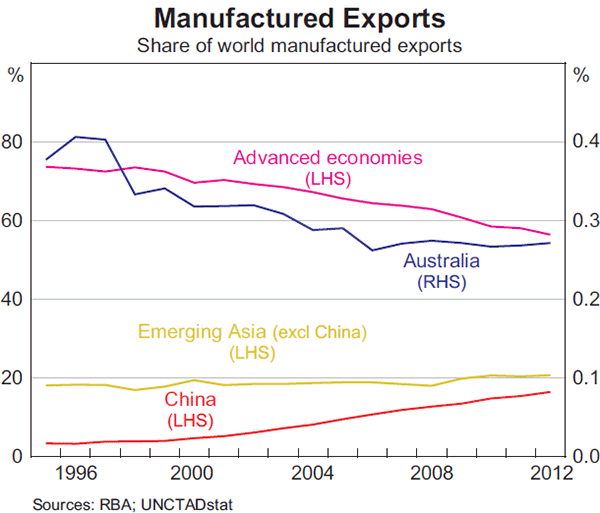
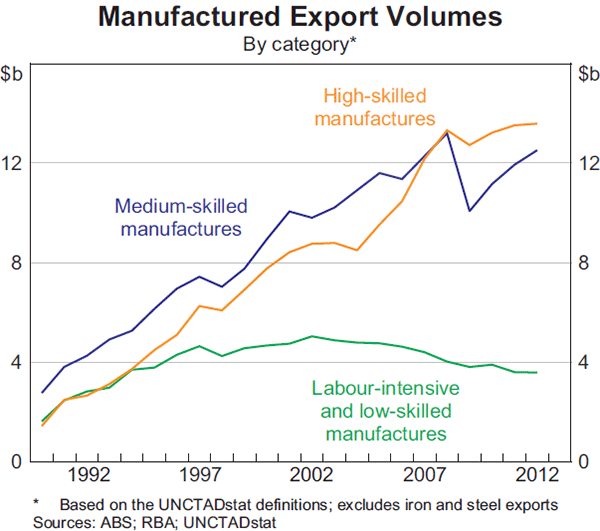
Despite the challenges faced by Australian manufacturers over recent years, there have been some industries which have experienced relatively strong export growth, particularly producers of high-skilled manufactures such as professional & scientific equipment and specialised machinery & equipment. This suggests that manufacturers of more highly skilled products have been able to adapt their business models to develop their presence in markets demanding these products despite the high exchange rate.
Surveys highlight the various ways in which firms have been adjusting their business practices to improve their competitiveness. According to the DHL Export Barometer, around a third of Australian exporters are looking at different markets or innovating in response to the high Australian dollar, while some firms are also increasing their use of imports, which have become cheaper as a result of the high exchange rate (Graph 17). This is consistent with findings from the ABS business characteristics survey, which indicate that manufacturing firms have been more actively reviewing their business practices in recent times (Lowe 2012).
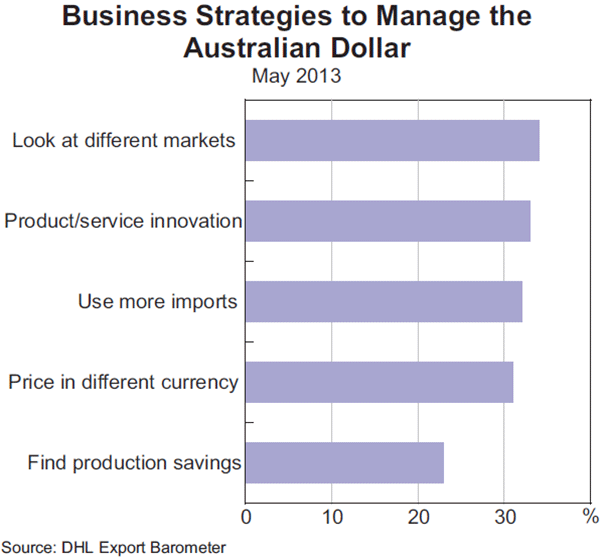
Some firms have also responded by withdrawing from export markets; the number of non-mining exporters declined by 3 per cent over the five years to 2011/12, with the number of manufacturing exporters falling by 10 per cent. Nevertheless, while the total number of firms involved in exporting has declined, the number of firms exporting to economies such as China, India, Thailand and Vietnam has increased over the period, consistent with a shift in focus towards emerging Asia.
Services Exports
Growth in services exports has also slowed over the past 10 years. While services export prices have grown at a similar pace to domestic prices, services exporters have still become less competitive in foreign currency terms as a result of the appreciation of the Australian dollar. Nevertheless, Australia's overall share of world services exports has been relatively steady over the past 10 years, which is a better performance than for other advanced economies (Graph 18). In part, this reflects the fact that Australia has been well placed to provide services such as tourism and education to consumers from emerging Asia.
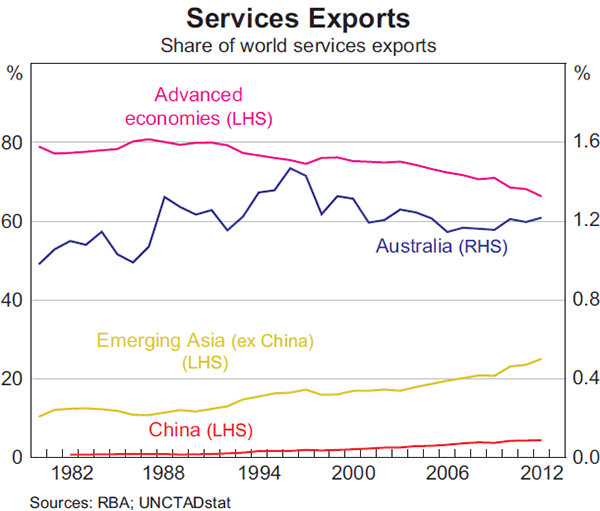
In aggregate, Australia's tourism exports have been flat over much of the past decade, with the industry hit by a range of negative shocks, including concerns about terrorism in the early 2000s, the appreciation of the Australian dollar and the global downturn in the late 2000s (Graph 19; Hooper and Van Zyl 2011). The number of tourist arrivals from emerging Asia, particularly China, has increased strongly over this period. In contrast, the share of arrivals from the more traditional Japanese and British tourist markets has declined. Consistent with this, China has become the most important source of export income for the Australian tourism industry since 2010/11 (Graph 20). The latest forecasts from the Tourism Forecasting Committee suggest that growth in arrivals from Asia will continue to support Australia's tourism industry over the period ahead.
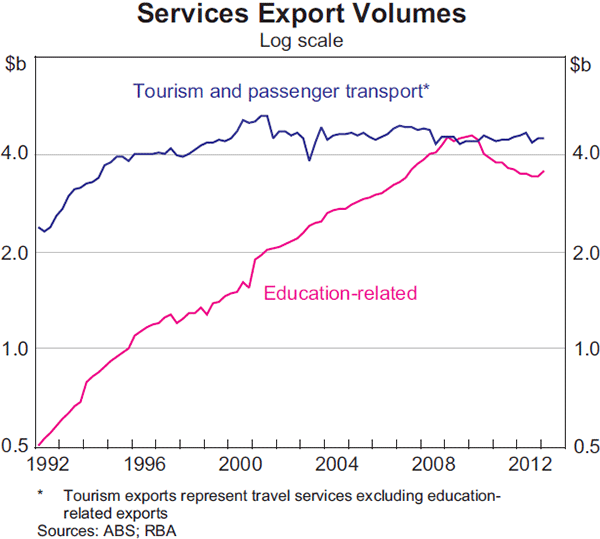
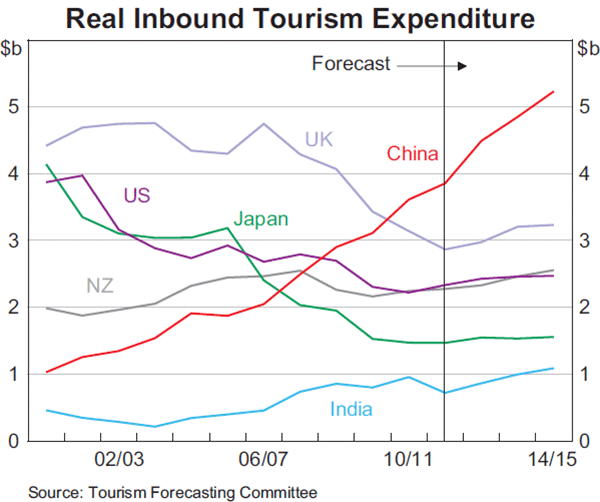
Education-related exports increased strongly during the 2000s, largely driven by demand from India and China. However, education-related exports have declined over the past three years following changes to the requirements for overseas students to obtain visas. The education sector has responded by focusing on costs, minimising fee increases and diversifying export-related programs, while the government has introduced further reforms to its student visa program. Over the past year, there have been signs that the decline in education-related exports has slowed and could have reached a trough. Indeed the Bank's liaison suggests that the number of overseas students commencing studies has increased at some universities over the past year.
Conclusion
Growth in Australia's exports has been relatively slow over the past 10 years, as a result of supply factors affecting resource and rural exports, as well as the effects of the high exchange rate and strong global competition on manufactured and services exports. Looking ahead, Australia is well placed to supply resources to the economies of emerging Asia as they continue to urbanise and industrialise. Moreover, as incomes grow strongly in the region, there will be increasing demand for Australia's exports of food products, high-skilled manufactures and services.
Footnotes
The authors are from Economic Analysis Department. [*]
For more details on steel demand and residential construction in China, see Berkelmans and Wang (2012). [1]
See, for example, Andrews and Arculus (2008) and RBA (2012). [2]
For further detail on the global LNG industry, see Jacobs (2011). [3]
Econometric studies find that an appreciation of the Australian dollar has a significant negative effect on manufactured export volumes. For example, see Dvornak, Kohler and Menzies (2003) and Norman (2006). [4]
References
Andrews D and R Arculus (2008), ‘Australian Exports and Developing Asia’, RBA Bulletin, June, pp 1–11.
Australian Government (2012), Australia in the Asian Century White Paper, Australian Government, Canberra.
Berkelmans L and H Wang (2012), ‘Chinese Urban Residential Construction to 2040’, RBA Research Discussion Paper 2012-04.
Connolly E and D Orsmond (2011), ‘The Mining Industry: From Bust to Boom’, RBA Research Discussion Paper 2011-08.
Dvornak N, M Kohler and G Menzies (2003), ‘Australia's Medium-run Exchange Rate: A Macroeconomic Balance Approach’, RBA Research Discussion Paper 2003-03.
Hooper K and M van Zyl (2011), ‘Australia's Tourism Industry’, RBA Bulletin, December, pp 23–32.
Hyvonen M and S Langcake (2012), ‘India's Steel Industry’, RBA Bulletin, March, pp 29–35.
Jacobs D (2011), ‘The Global Market for Liquefied Natural Gas’, RBA Bulletin, September, pp 17–27.
Lowe P (2012), ‘The Changing Structure of the Australian Economy and Monetary Policy’, RBA Bulletin, March, pp 79–84.
Maddison A (2009), ‘Statistics on World Population, GDP and Per Capita GDP, 1–2008 AD’. Available at <http://www.ggdc.net/MADDISON/Historical_Statistics/horizontal-file_02-2010.xls>.
Norman D (2006), ‘Modelling Manufactured Exports: Evidence from Australian States’, RBA Research Discussion Paper 2006-01.
Plumb M, C Kent and J Bishop (2013), ‘Implications for the Australian Economy of Strong Growth in Asia’, RBA Research Discussion Paper 2013-03.
Rayner V, E Laing and J Hall (2011), ‘Developments in Global Food Prices’, RBA Bulletin, March, pp 15–21.
Rayner V, N Tan and N Ward (2010), ‘Trends in Farm Sector Output and Exports’, RBA Bulletin, December, pp 1–8.
RBA (Reserve Bank of Australia) (2012), ‘Box C: Resource Exports in 2011’, Statement on Monetary Policy, May, pp 43–45.